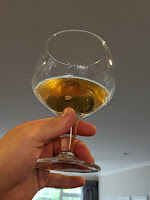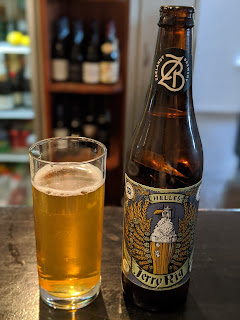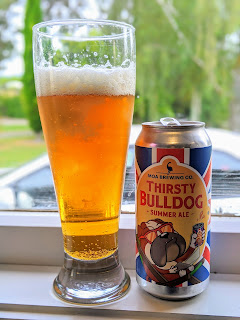Virgin mead
I don't really know much about mead, in fact I've never tasted it. I can't find any in shops (although I have just seen that there's a kiwi meadery [is that a word?] Lone Bee so I'll try and get my hand on some of that). So I thought I'd give it a crack and make a small (750mL) batch and find out (since writing this, I've bought, drank and reviewed the Lone Bee Mead). I gather that it may take 6 months or so mature properly, so we'll see if I can hold out that long.
Mead is just fermented honey, and I understand can be anywhere from about 5-15% ABV, and can be sparkling or still. Can be just honey, water and yeast, or can have some other bits added for flavour, like vanilla, cinamon, hops or I guess whatever else (I'm thinking some smokiness would go well, not sure how to achieve that though).
So I'm going for something 5-10% ABV(I'm not going to measure) and sparkling (a "small mead"), and no additives, although I'm using a leftover Pilsner yeast, so there may be some residual hops and beer mixed in the yeast slurry.
Honey is something I've only recently come to appreciate (due to having lived nearby Arataki honey in Hawke's Bay). The plants that the bees get the pollen from have a massive impact on the texture, colour, smell and of course flavour of the honey. It's clearly not that easy to figure out where bees get their pollen from, so making "pure" Manuka honey, for example, is pretty tricky for the poor old beekeepers; and there are tests to be done on the end product to prove that it has over a threshold of Manuka in it. I've used a "bush" honey, which I think basically means there are no restrictions on the bees, and they go where they like, and you get what you get.
Ingredients
- 150mg honey
So I'm going for something 5-10% ABV(I'm not going to measure) and sparkling (a "small mead"), and no additives, although I'm using a leftover Pilsner yeast, so there may be some residual hops and beer mixed in the yeast slurry.
Honey is something I've only recently come to appreciate (due to having lived nearby Arataki honey in Hawke's Bay). The plants that the bees get the pollen from have a massive impact on the texture, colour, smell and of course flavour of the honey. It's clearly not that easy to figure out where bees get their pollen from, so making "pure" Manuka honey, for example, is pretty tricky for the poor old beekeepers; and there are tests to be done on the end product to prove that it has over a threshold of Manuka in it. I've used a "bush" honey, which I think basically means there are no restrictions on the bees, and they go where they like, and you get what you get.
Ingredients
- 150mg honey
- 550mL water
- Pilsner yeast (harvested after being brewed on Pilsner; a wee bit of residual hoppiness expected)
Process
Water boiled, then honey added as it cooled. Put into a sterilised wine bottle to cool in the fridge until pitching (room) temperature reached.
Water boiled, then honey added as it cooled. Put into a sterilised wine bottle to cool in the fridge until pitching (room) temperature reached.
Then about 20mL of yeast slurry thrown in on top. The yeast slurry WLP800 (White Labs Pilsner Yeast), which I'd recently used on a Pilsner - I'd collected it using a conical fermentor after discarding the trub, but there was definetely a small amount of beer blobs (hops and malt sediment) and a nice beery smell about it. I'm unsure how much that will affect the final mead. I then stuck a bung and a bubbler (air lock) on the top to let it ferment.
Within 8 hours the whole thing had gone from a beautiful clear honey coloured liquid to a mucky yeasty colour (as fermenting alcohol does) and the bubbler was completely clogged with overflowing meady yeasty gunk, and bubbling away madly. Perhaps next time a 2L flask would be a better idea (my flask was in use with Kombucha!)
It took several weeks to clear, but when it did over about 2-3 days it went from mud to crystal clear with a good chunk of sediment at the bottom. A week or two later I decanted it from one wine bottle to another (sanitised), and left it to age for a few months.
Finally gave it a crack after just over two months in the bottle, not really knowing what to expect. It was in an airtight bottle, so I thought it might have a little carbonation, but it didn't. The initial smell had a slight tinge of honey and a slight tinge of Pilsner (clearly the yeast). Poured almost crystal clear, but dead still with no hint of carbonation. I wasn't quite sure what to drink it out of, so I had one in a shot glass, one in a big wide Belgian beer glass, and one in a wine glass - I think the wine glass worked best. I really enjoyed the taste - really like honey without the sweetness. I never measured the specific gravity so I can't confidently comment on the alcohol, but I'd hazard a guess around 10-12% from the taste (and the effect). There is a hint of yeastiness and a hint of beeriness from using a spent Pilsner yeast; neither are particularly good in this setting. Aside from that no real off flavours (I wonder if a single clove in the bottle would mask the flavour).
Overall I'd call it a sucess - I had fun brewing something new, I got to taste something new, and I liked it. I still have half the bottle in the fridge waiting for a day to meet my insides.
I read some post on Facebook about Vikings drinking a half mead - half ale mix, so I did try that (well actually it was half mead - half lager) and it wasn't too bad... but I think I prefer either on their own than the combination.
Next time I might experiment with some fruit or cloves or something... Or maybe some smoke (smoked rosemary maybe?).











Comments
Post a Comment